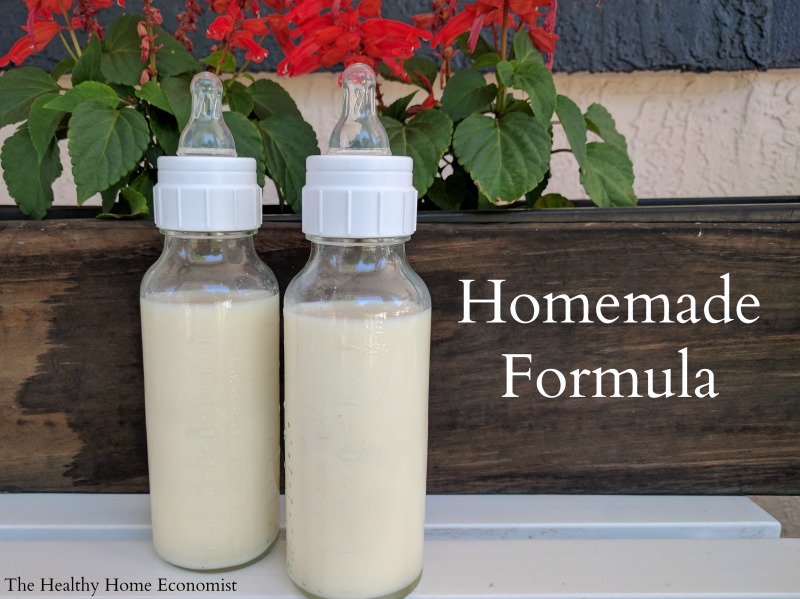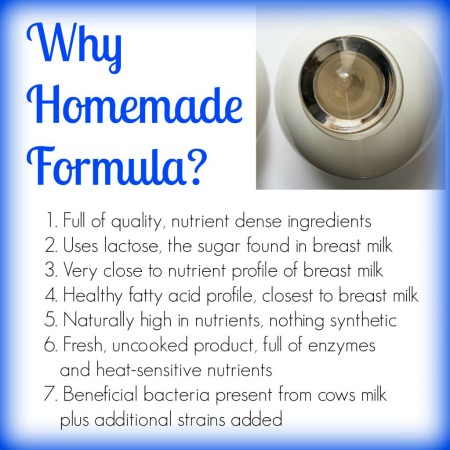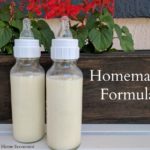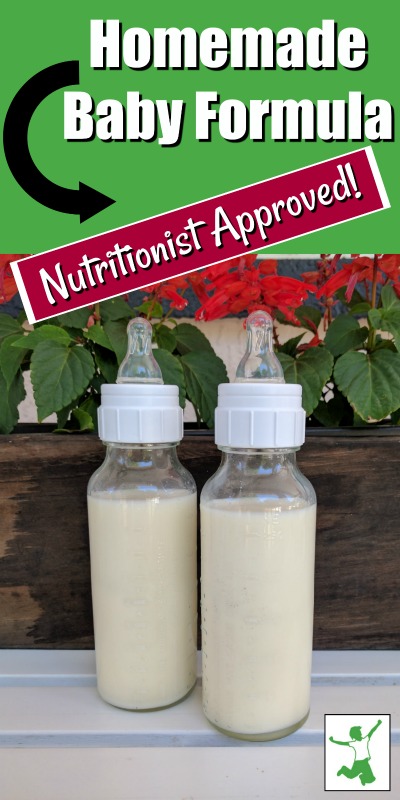Table of Contents[Hide][Show]
A nourishing homemade baby formula using safe, whole ingredients. This recipe was developed and tested by Dr. Mary Enig, a PhD Nutritionist and originally published in Nourishing Traditions cookbook in 1996. It was formulated to match breastmilk as closely as possible and is also suitable for infants. Source: Weston A. Price Foundation

There is no doubt that breastfeeding your baby is the best option for the child’s long-term health and development. Human breastmilk from a well-nourished mother is the perfect food for baby. However, in circumstances where the child is adopted or the Mother finds herself unable to breastfeed, formula feeding becomes necessary. In those cases, homemade baby formula is best.
Using a baby formula recipe that closely matches the nutritional profile of breastmilk is a far better choice than even organic baby formula from the health food store. More on this below.
Note: Donor programs are widely available for human breastmilk. But, the diets of the donor mothers are unknown and most likely nutritionally insufficient. In addition, breastmilk banks pasteurize the donated breastmilk which destroys much of the nutritional benefit. Unless you are fortunate to have a trusted and direct donor milk source in your community, avoid this option!
Dangers of Commercial Formula
Commercial formulas are always a poor choice for a number of reasons. First of all, formula manufacturers line the cans with the chemical BPA. This substance disrupts hormone development and is a probable contributor to early puberty in girls, and ADHD, urogenital abnormalities, and other ills in boys.
The European Food Safety Authority found that canned commercial formula is a significant source of BPA for infants, exposing the child to 13mcg of BPA per kg of body weight per day! BPA-free formula cans are no better. The chemical BPS is typically used instead which is just as dangerous.
Beware that manufacturers pack even organic commercial formula like Earth’s Best in BPA cans. Worse, they use organic brown rice syrup as the primary sweetener which is known to be frequently contaminated with arsenic.
In addition, all commercial milk formulas are processed at extremely high temperatures which violently denature the fragile milk proteins, render them allergenic, and add carcinogens to the final product. Soy infant formula is the worst. Obscenely high processing temperatures not only denature the proteins but large levels of phytic acid in soy block mineral absorption by the infant. Moreover, soy-based plant estrogens disrupt the hormonal development of the baby!
It seems that for the concerned Mother who is unable to breastfeed, learning how to make baby formula at home with safe, pure ingredients is the most prudent way to go!
Why Make Homemade Formula Even if You Are Breastfeeding
In the video below, I show you how to make your own safe, healthy raw milk homemade formula for your baby.
The recipe I follow was originally published in the cookbook Nourishing Traditions in 1996 and developed by Dr. Mary Enig.
Even though I breastfed each of my children for at least 2 years, I made this exact formula for my own children when I was away for the day or the evening as pumping was not an option that worked well for me.
I even used this homemade formula for an entire day once when I had some dental work done and was advised to pump and discard for 24 hours.
As a result, even successfully breastfeeding Moms can use this wonderful homemade formula as a supplement when necessary to their own nutrient-dense breastmilk!
It is advised that even breastfeeding Mothers have the ingredients for this formula on hand for an emergency. If Mom is sick or otherwise unable to nurse, Dad can step in and make this safe alternative until Mom is back on her feet. It takes a few days to a week to gather all the ingredients together to make this formula, which is why I advise having them on hand at all times.
Homemade Most Nutritious
The image below lists the reasons why it is worth it nutritionally to make formula yourself for your precious baby!
You can order all of the required ingredients for the homemade baby formula in one package from this reputable, vetted source.
Moms who have successfully used this formula feeding your children, please post about your experience in the comments section to encourage those who are considering it and need some Mom to Mom encouragement!

Where to Source Quality Milk
The most widely available grass-fed milk around the world is from cows. This is usually the most budget-friendly and easily sourced milk for this recipe for homemade formula.
If only goat milk is available in your area, this recipe for goat milk baby formula can be used instead. When using milk from ewes, please refer to the linked article for an adjusted recipe; one of the benefits of sheep milk is that it is higher in healthy fats than either goat or cow milk.
Camel milk formula is another option that is a particularly digestible form of dairy and growing in popularity around the world.
Alternatively, you can use low temp (vat) pasteurized, non-homogenized whole milk cultured with a piima or kefir starter. Then substitute the piima milk or kefir for the raw milk portion of the formula recipe. Cold-pressed raw milk also must be cultured before using it as it contains no probiotics.
Do NOT use ultrapasteurized (UHT) milk even if organic as it is too highly processed and extremely allergenic!
It is also best to avoid all types of powdered milk for this recipe. The factory process of making milk powder reduces nutrition considerably and denatures it, which makes it more likely baby will have an allergic reaction.
Dairy Allergy Option
If all types of dairy prove unsuitable for your baby, make this nondairy baby formula recipe instead. It uses a base of homemade bone broth as a substitute for milk. It is important not to utilize a plant-based or otherwise vegan baby formula recipe.
Avoid buying bone broth to make the dairy-free formula. Make it yourself! Manufacturers of commercial bone broth, even if authentic, may water down the end product. This is apparent if it does not gel when chilled in the refrigerator.
Many brands have toxic packaging issues as well. If you must buy it in a pinch, see my shopping guide page for vetted brands that are safe.

Homemade Baby Formula Recipe (for infants too)
A nourishing baby formula recipe you can make at home with safe, whole ingredients developed and tested by a PhD nutritionist to match breastmilk as closely as possible. Also suitable for infants.
Ingredients
- 2 cups raw cow milk OR organic whole milk yogurt
- 1 7/8 cups filtered water
- 1/4 cup liquid whey
- 4 Tbl lactose
- 1/4 tsp Bifidobacterium infantis powder
- 2-4 Tbl raw or pasteurized cream
- 1/2 tsp cod liver oil unflavored
- 1/4 tsp butter oil unflavored
- 1 tsp sunflower oil preferably organic
- 1 tsp extra virgin olive oil preferably organic
- 2 tsp virgin coconut oil preferably organic
- 2 tsp nutritional yeast
- 2 tsp gelatin
- 1/4 tsp acerola powder
Instructions
-
Fill a 2 cup Pyrex measuring cup with filtered water and remove 2 TBL (this will give you 1 7/8 cup water).
-
Pour about half the water into a pan and turn burner on medium.
-
Add the gelatin and lactose and let dissolve, stirring occasionally.
-
When gelatin and lactose are dissolved, remove pan from heat and add the rest of the water to cool.
-
Stir in the coconut oil and butter oil until melted.
-
Put remaining ingredients in a glass blender.
-
Add the water mixture and blend for about 3 seconds.
-
Place formula in glass baby bottles or a glass jar and refrigerate.
-
Before giving to baby, warm glass bottle in a pan of hot water or a bottle warmer. NEVER microwave baby bottles!
Recipe Video
Recipe Notes
If using raw cow milk from holstein cows, use 4 Tbl of extra cream (otherwise use 2 Tbl extra cream).
If choosing to make this homemade formula with camel milk, be sure to include 4 Tbl extra cream as camel milk is lower in cream than cow milk.
Do not use high oleic sunflower oil. Use only the brand recommended in the ingredients list which is cold pressed, organic, unrefined, and low oleic.
*Do NOT use powdered whey from the store as it is denatured. Avoid whey from making cheese as it will curdle the formula.
*Do not substitute pasteurized or powdered milk as these are heavily processed, denatured and allergenic foods.
*Do NOT use ultrapasteurized (UHT) cream. It is highly allergenic. Raw or pasteurized cream is acceptable.
*Do NOT use fish oil or krill oil instead of high vitamin cod liver oil as they do not contain any Vitamin D and very little to no Vitamin A.
Collagen powder may be substituted for the gelatin in a pinch (more on peptides in baby formula in this article).
If you are wondering where is the iron in homemade baby formula, this article provides an explanation.
If baby experiences constipation using this formula, try adding 1 tsp of molasses to each batch. This should help move things along.
How to Transition to DIY Formula
Once you’ve viewed the video, gathered the ingredients, and made your first batch, how do you feed it to your baby for the first time?
It is important not to switch all at once as this can cause gas, excessive spit-up, or an uncomfortable change in diaper habits such as constipation or overly loose stools.
Start by giving your baby three-quarters of the old formula blended with one-quarter of the homemade. Try this ratio for a day or two and see how your infant responds.
If no digestive upset or major change in diaper habits occurs, increase the amount to a 50-50 blend of old formula to homemade. Observe for another day or two as before.
If no major issues, increase once again to three-quarters homemade formula to one-quarter old formula. If baby does well on this blend for a third time, you are ready to fully transition to the homemade formula.
At any time during the transition, symptoms of intolerance emerge, back up to the previous successful blend ratio and stay there for a day or two before attempting to increase once again.
Homemade Formula FAQ
Weston Price Foundation
Feeding an Adopted Baby
Traveling Tips with Baby Formula Made at Home
Iron in Baby Formula
Collagen Peptides instead of Gelatin for Homemade Formula?










Here in Indonesia we dont have such complete ingredients like acerola powder, sunflower oil, fermented cod liver oil ,, what are the subtitutes for them
My daughter’s milk started drying up when she went back to work when my granddaughter was 3mos. she had a hard time with pumping so I “googled non gmo baby formula and loved Food Babes page on it. She compares about 6 organic formulas with charts and the best one is Baby’s Only. It’s a toddler formula but has all the (ha ha) FDA requirements for infants – I started mixing it with breast milk at first while I could – now my granddaughter is 8 mos and is chubby and very happy and lively – she’s done well on this with minor digestion issues in the beginning that I handled with essential oils… BIG IF it would of been my choice she would still be being breast fed – but she’s not my daughter only my granddaughter and I can only beat my daughter over the head so much about clean and healthy eating – she’ll maybe figure it out on her own… Just wanted to share the results with the Baby’s Only..It’s even less expensive than the other formulas, I just don’t have the time and the means to make homemade for her or I would…
Thanks for listening
I am making the whey from raw milk, but am wondering if I should remove the cream before I do or should I leave the cream in – Maybe it doesn’t matter?
On a side note, I looked online for how many grams of protein about is in the liquid whey but could not find any information – Any idea?
Thanks for the info on homemade formula, I am looking forward to making it!
Hi, I have to fortify for my little one who has weight gain issues and a heart condition. I am still pumping and I want to use my milk instead of cow’s. How might that affect our change the recipe?
Pls can anyone help!
I am doing the cow milk formula and have been taking out the whey, gelatin and nutritional yeast are there any supplementations for these items…..
Very scared and concerned not wanting little one to lack necessary nutrients or vit.
Since the iron and vit d are low in cows milk formula any advice on supplementation???
Pls someone , anyone help!
Deborah, Is there a reason why you are leaving those ingredients out? (colic, etc?) If not, do put them in because they are beneficial. However, when I talked to my naturepath about the formula, she understood the purpose of each ingredient but also said she has had babies flourish simply on cow’s milk, cod liver oil and pro-biotic. Her point was to not over-think it. I ended up using everything but the whey. Isaac did wonderfully on it. He was 5 mos. old when I had to start weaning him off of me due to health issues (mine). I guess bottom-line is, don’t over-think it, do what you can do, incorporate what you can, and go with your mama intuition. If your baby is thriving, that means its working!
Alicia thank you so much for your response……
Duke reacts to all those ingredients.Its been 3 dys since we have been on it? and as of today beeing the 3rd day he is spitting up cottage cheese like stuff the whole day, is this normal?
hi deborah,
this is happening with my son too.
on the goat milk this doesnt happen …. no vomiting and any little soit up dont smell….BUT he is more unsettled on goats????? seems more irritable and hungrier….
do the smelly cottage cheese like vomits mean his body rejects the cows milk??
Hello can I ask what quantity per day was your baby taking? I have not seen anything that specifies how much a baby should consume with regard to their age. I want to trial the bone broth formula with my son but I’m concerned about correct daily nutrient intake as too much/too little of some vitamins and minerals can be harmful. Also, how long did you find one quantity of the formula recipe would last? Thanks
Hello! I am running out I my store of breastmilk and considering home made. Unfortunately he only way I can get raw milk is through a cow share which I don’t want to do unless this is going to stick with my daughter. My option is local low temp pasteurized non- homogenized milk. I saw how to get a culture for kefir, do you have video to show this? Not sure f I could keep up a culture every day or two. I would love to see how difficult or easy it is as far as time commitment on top of formula making. Also, are glass bottle necessary or can I use bpa free? I would use glass for storage but after going through every bottle and nipple on the market to find one she would take, I can’t switch to glass.
Making the formula is a commitment – but a worthy one! Because I live in MT, my only option was the low-pasteurized whole milk at the good food store. I tried culturing it at first, but my baby did not respond well to the ‘sour’ taste. I ended up not making it into kefir and he did just fine. In the fridge I store it in glass, but his bottles are bpa free plastic. All the oils do make it harder to clean the plastic, but doable! Hope my experience helps!
Hi! You stated that you used low temp pasteurized whole cows milk for your baby? Eventually NOT culturing it? I have been considering this because honestly even with the lactose it’s so sour and has a curdled texture no matter what I do. I am still breastfeeding and using this recipe as a supplement, so my baby is still getting a “living” food from me. Please share your experience with using non cultured low temp pasteurized. Thank you!!
Hello There. I found your weblog using msn.
This is an extremely smartly written article.
I will be sure to bookmark it and come back to read more of your helpful information.
Thank you for the post. I’ll certainly comeback.
Hello, I’m just wondering is all this that’s added in homemade formula safe for a baby to directly consume? Since breast milk is everything a baby needs but the mother directly consumes the food and after the body works it over and digests it properly then the baby gets the milk, but directly feeding the baby this will it be too much for the kidneys or organs to digest? I’m just a little worried… But I really want to try it.
Do you have direction anywhere on how to use kefir grains to bring pasteurized milk back to life? I cannot get any raw milk. Would buying kefir already prepared be an option instead of the milk?
Thanks!
I tried the kefir grains… Fermenting about 12hours. It made it too sour. Upon my naturepath’s advice, i eliminated the fermenting process and the whey. Isaac thrived beautifully from 6months old onwards consuming it this way.
So you left out making your own whey and kept the milk pasteurized?
Every time I’ve blended my milk even for 1 second it gets this thick solid like foam on the top that clunks and drops into the container when I pour it out? What am I doing wrong?
It more than likely is all the oils hardening. I had this problem too. I’d either shake it up from time to time through-out the day, divide it up into bottles right away so the oils were evenly distributed, or put back some of the chunks iinto the main container if too much went into the bottle while pouring… All depending what i had time for. A bit of a nuesence, but worth it.
I pulse blend for about five seconds and do get quite a layer of form on top, I think its normal. I take the finished formula and put it into clean ball jars store in fridge. Before pouring into bottles I shake it up real well to make sure its fully blended. We have been using this formula for 4 months with our adopted son since he was 2.5 days old and he is doing wonderfully!!!